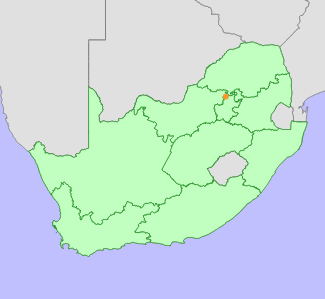|
Scientific Name | Brachystelma discoideum R.A.Dyer |
Higher Classification | Dicotyledons |
Family | APOCYNACEAE |
National Status |
Status and Criteria | Critically Endangered (Possibly Extinct) |
Assessment Date | 2016/08/24 |
Assessor(s) | N. Hahn, L. Mills & L. von Staden |
Justification | This species is possibly extinct at the type locality, where it has not been seen since 1968, despite many repeated searches. There are some indications that it possibly has a wider distribution in similar sandy bushveld habitat in North West and Mpumalanga provinces, but there has been no other collections or confirmed records. It is possibly extinct, but more field surveys in suitable habitat is needed. |
Distribution |
Endemism | South African endemic |
Provincial distribution | Gauteng |
Range | Shoshanguve, north of Pretoria, possibly extending to western Mpumalanga and north-eastern North West Province. |
Habitat and Ecology |
Major system | Terrestrial |
Major habitats | Central Sandy Bushveld |
Description | Gravelly, sandy soils in bushveld. |
Threats |
| The habitat at the type locality is protected, but is nonetheless quite degraded due to historical salt mining activities. There is also ongoing degradation due to livestock grazing in the reserve, and there is very little conservation management. Threats at Thabazimbi and KwaMhlanga are not known, as no precise locality information is available. |
Population |
Tubers of species was first collected in 1968, and then established in cultivation. It flowered in December 1971, when it was recognised as a distinct species and described. Follow-up visits to the type locality however failed to locate more plants (Dyer 1980). Several further searches at the type locality have thus far also failed to locate this species (L. Mills pers. comm. 2016). There are unconfirmed reports of this species occurring near KwaMhlanga in Mpumalanga (where there is similar habitat to the type locality), as well as near Thabazimbi in North West Province.
|
Population trend | Decreasing |
Assessment History |
Taxon assessed |
Status and Criteria |
Citation/Red List version | | Brachystelma discoideum R.A.Dyer | CR PE | 2017.1 | | Brachystelma discoideum R.A.Dyer | EN B2ab(ii,iii,iv) | Raimondo et al. (2009) | | Brachystelma discoideum R.A.Dyer | VU B2ab(ii,iii,iv) | Pfab and Victor (2002) | | Brachystelma discoideum R.A.Dyer | VU B1B2bcd | Victor (2002) | | Brachystelma discoideum R.A.Dyer | Rare | Hilton-Taylor (1996) | |
Bibliography |
Dyer, R.A. 1973. Brachystelma discoideum. Flowering Plants of Africa 42:t. 1668.
Dyer, R.A. 1980. Brachystelma, Ceropegia and Riocreuxia. In: O.A. Leistner (ed). Flora of Southern Africa 27 Part 4:1-88. Botanical Research Institute, Pretoria.
Dyer, R.A. 1983. Ceropegia, Brachystelma and Riocreuxia in southern Africa. A.A. Balkema, Rotterdam, Netherlands.
Hahn, N. 2013. Rare, endangered and endemic flora of the North West Province. Unpublished Report to the Department of Economic Development, Conservation and Tourism, North West Provincial Government.
Hilton-Taylor, C. 1996. Red data list of southern African plants. Strelitzia 4. South African National Botanical Institute, Pretoria.
Pfab, M.F. and Victor, J.E. 2002. Threatened plants of Gauteng, South Africa. South African Journal of Botany 68:370-375.
Raimondo, D., von Staden, L., Foden, W., Victor, J.E., Helme, N.A., Turner, R.C., Kamundi, D.A. and Manyama, P.A. 2009. Red List of South African Plants. Strelitzia 25. South African National Biodiversity Institute, Pretoria.
Victor, J.E. 2002. South Africa. In: J.S. Golding (ed), Southern African plant Red Data Lists. Southern African Botanical Diversity Network Report 14 (pp. 93-120), SABONET, Pretoria.
|
Citation |
| Hahn, N., Mills, L. & von Staden, L. 2016. Brachystelma discoideum R.A.Dyer. National Assessment: Red List of South African Plants version 2024.1. Accessed on 2025/10/18 |
 Comment on this assessment
Comment on this assessment


